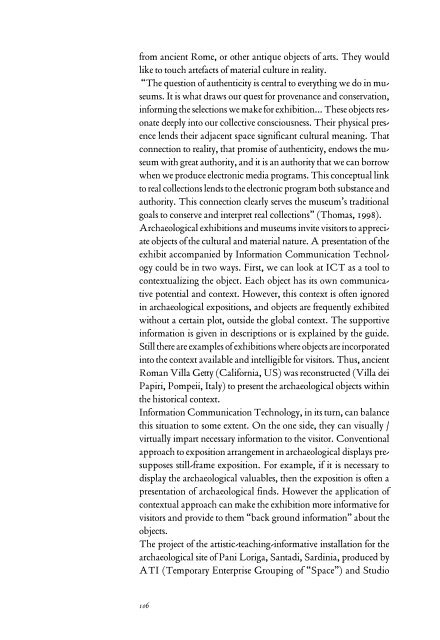Download ebook FREE - Allemandi
Download ebook FREE - Allemandi
Download ebook FREE - Allemandi
You also want an ePaper? Increase the reach of your titles
YUMPU automatically turns print PDFs into web optimized ePapers that Google loves.
from ancient Rome, or other antique objects of arts. They would<br />
like to touch artefacts of material culture in reality.<br />
“The question of authenticity is central to everything we do in museums.<br />
It is what draws our quest for provenance and conservation,<br />
informing the selections we make for exhibition... These objects resonate<br />
deeply into our collective consciousness. Their physical presence<br />
lends their adjacent space significant cultural meaning. That<br />
connection to reality, that promise of authenticity, endows the museum<br />
with great authority, and it is an authority that we can borrow<br />
when we produce electronic media programs. This conceptual link<br />
to real collections lends to the electronic program both substance and<br />
authority. This connection clearly serves the museum’s traditional<br />
goals to conserve and interpret real collections” (Thomas, 1998).<br />
Archaeological exhibitions and museums invite visitors to appreciate<br />
objects of the cultural and material nature. A presentation of the<br />
exhibit accompanied by Information Communication Technology<br />
could be in two ways. First, we can look at ICT as a tool to<br />
contextualizing the object. Each object has its own communicative<br />
potential and context. However, this context is often ignored<br />
in archaeological expositions, and objects are frequently exhibited<br />
without a certain plot, outside the global context. The supportive<br />
information is given in descriptions or is explained by the guide.<br />
Still there are examples of exhibitions where objects are incorporated<br />
into the context available and intelligible for visitors. Thus, ancient<br />
Roman Villa Getty (California, US) was reconstructed (Villa dei<br />
Papiri, Pompeii, Italy) to present the archaeological objects within<br />
the historical context.<br />
Information Communication Technology, in its turn, can balance<br />
this situation to some extent. On the one side, they can visually /<br />
virtually impart necessary information to the visitor. Conventional<br />
approach to exposition arrangement in archaeological displays presupposes<br />
still-frame exposition. For example, if it is necessary to<br />
display the archaeological valuables, then the exposition is often a<br />
presentation of archaeological finds. However the application of<br />
contextual approach can make the exhibition more informative for<br />
visitors and provide to them “back ground information” about the<br />
objects.<br />
The project of the artistic-teaching-informative installation for the<br />
archaeological site of Pani Loriga, Santadi, Sardinia, produced by<br />
ATI (Temporary Enterprise Grouping of “Space”) and Studio<br />
106







